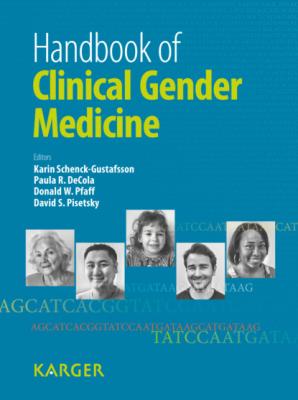ТОП просматриваемых книг сайта:
Handbook of Clinical Gender Medicine. Группа авторов
Читать онлайн.Название Handbook of Clinical Gender Medicine
Год выпуска 0
isbn 9783805599306
Автор произведения Группа авторов
Издательство Ingram
öberg, K. (Stockholm)
Buvat, J. (Lille)
Carrero, J.-J. (Stockholm)
Section Editor: Parekh, A. (Silver Spring, Md.)
Parekh, A. (Silver Spring, Md.)
Mattison Faye, A.C. (Columbia, S.C.); Mattison, D.R. (Bethesda, Md./Ottawa, Ont.)
Section Editor: Herlitz, A. (Stockholm)
Aging in a Gendered Society: Social and Biological Determinants of Health in the Elderly Population
Parker, M.G. (Stockholm)
Mangialasche, F.; Marengoni, A.; Kivipelto, M. (Stockholm)
Wang, H.-X.; Kivipelto, M. (Stockholm)
Herlitz, A.; Lovén, J. (Stockholm)
No one should be sick or die because of gender inequality
The World Health Organization Department of Gender, Women, and Health
The authors you will read in the Handbook of Clinical Gender Medicine have responded to the intriguing challenge of describing their discipline through the lens of both gender and sex differences. Grappling with sex and gender requires skills in both the biomedical and social sciences, and when those two thought systems come together, a revolution is in the making. The Handbook of Clinical Gender Medicine addresses this challenge across twelve body systems, providing evidence about the implications of gender and sex in relation to presentation, diagnosis, and treatment of disease processes. It is both practical and useful, as a textbook should be.
The authors who have contributed to the Handbook of Clinical and Gender Medicine have explained how sex and gender affects medical understanding of pain, epilepsy, violence, metabolic bone disorders, heart disease, and malaria, among other conditions. This is a medical textbook that is both the same as the leading texts that resource clinical practice and yet profoundly different. The promise is that once you have read this textbook you will understand your branch of medicine with new vision for the rest of your life as a clinician.
All of us, scientists, doctors, and patients, can be grateful for the contributions of the pioneering authors in this textbook. We encourage you to enjoy the insights that their use of the gender lens generates in their respective disciplines and to apply it to your own work in patient care. It is a joy to read this foundational text on the emerging field of gender and medicine.
|
|
|
| Jo Wainer, Clayton, Vic./Box Hill, Vic., Australia | Zoe Wainer, Melbourne, Vic., Australia |
The idea for this book came to me gradually during the first years of the new millennium after we had opened the Center for Gender Medicine at Karolinska Institutet, in Stockholm, Sweden, in 2001. At our 3rd International Congress of Gender Medicine in Stockholm in 2008, we had a preliminary book meeting and many colleagues seemed interested in the project. At about the same time, the Center obtained funding from Pfizer Inc. to support the development of this book.
An executive committee was formed and its members consist of, besides me (Prof. Karin Schenck-Gustafsson, Karolinska Institutet, Stockholm): Paula R. De Cola, RN, MSc, Pfizer, New York, N.Y., USA; Prof. David S. Pisetsky, Duke University, Durham, N.C., USA, and Prof. Donald W. Pfaff, Rockefeller University, New York, N.Y., USA. The journalist Tina Esh, BSc, Tina Esh Communications AB, Stockholm, is the book coordinator.
We first had to decide on the content of the book. High priority was that it should serve as a guide for clinical work. Therefore, most chapters are very clinical while a few are more theoretical or philosophical, depending on the nature of the topic.
The chapters should contain statements about the actual status of knowledge as well as comments about missing facts. We hope that this book will inspire others and lead to more research, more work on clinical guidelines, and more advocacy for gender medicine considerations among groups such as health authorities, ethics committees, editorial boards, research councils, medical product agencies, and biopharmaceutical companies.
It was a long struggle to find a publisher that understood our intentions and shared the beliefs that gender medicine is both for men and women, includes both biological and social aspects of health and disease, is based on top-quality research, and in the future will be a natural part of all research and clinical work. I also believe that our authorities should demand that all medical research include both sexes, show sex-divided statistics, and always analyze results from a sex and gender perspective.
We have engaged authors that are top researchers and top clinicians from Europe, the USA, Canada, Africa, China, and Australia who share my passion for the heightened prominence of gender medicine, and I believe that we have an outstanding book that will contribute to this goal.
Enjoy the reading!
Karin Schenck-Gustafsson, Stockholm
Introduction
Schenck-Gustafsson K, DeCola PR, Pfaff DW, Pisetsky DS (eds): Handbook of Clinical Gender Medicine.
Basel, Karger, 2012, pp 1–4
______________________

